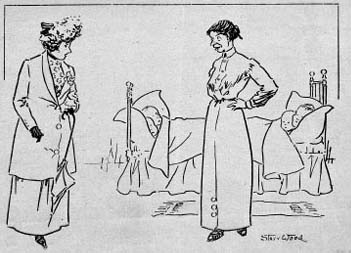7.2 The public take control
There is also good evidence which suggests that the public took control over their own health by choosing not to seek medical help, or by rejecting offers of help and treatment (Figure 10).

The Women's Health Enquiry survey of working-class women of 1933 showed that a large proportion of working-class women suffered from chronic illnesses which went untreated (Spring Rice, 1981, pp. 28–43). The next reading is an extract from this survey, published in 1939.
Activity 5
Read ‘The health of working-class women’ (. What reasons does the author give for the women not receiving treatment? In the light of this source, do we need to revise our idea that state intervention ensured healthcare for all sections of society?
Click to view the article 'The health of working-class women [Tip: hold Ctrl and click a link to open it in a new tab. (Hide tip)] '.
Answer
The author suggests that while cost was the greatest barrier to healthcare, the women had many reasons for not seeking treatment: a ‘disinclination to fuss’ over themselves, greater concern with the health of their families, exhaustion, ignorance and prejudice. The women surveyed had a fear of any sort of operation – from minor dental work to major surgery.
The results of the Women's Health Enquiry survey showed that many women were not well served by government healthcare services – relatively few went to panel doctors or used clinics. The reading suggests that while ensuring that the population could afford medical advice and therapy was an important step towards ensuring healthcare for all, it was not the whole story. In order for the women in this survey to seek medical help, they also needed support in getting to the hospital or clinic and in looking after the home while they underwent treatment. Women also had to be cured of their fear of surgery.
Patients also rejected offers of care for venereal disease and tuberculosis. VD sufferers were reluctant to undergo the long and painful therapies used to treat syphilis and gonorrhoea, and often did not complete the courses of treatment. People infected with TB also refused opportunities for treatment, for fear of being stigmatised. There was a widespread fear of people with TB. Long after doctors realised that tuberculosis was infectious, many people continued to believe that the disease was hereditary, and would be passed on from parent to child. Patients were often unwilling to come forward for treatment or to follow the advice given, for fear of being identified as a ‘lunger’. One patient wrote: ‘It is depressing to find how frightened people are becoming of us. I am being turned out of my rooms, and this will make my fourth move in this particular town’ (Bryder, 1988, p. 223). People infected with TB were dismissed from their jobs, and even those who recovered from the disease found it very difficult to find employment.
Inpatient care in specialist sanatoria, with its emphasis on fresh air at all times and a rich diet, was also unpopular. In the following reading, Linda Bryder describes patients' attitudes towards the strict sanatorium regime.
Activity 6
Read ‘Resistance to care – sanatorium treatment’. Are the patients happy to accept the prescribed regime? How successful are the sanatoria staff in imposing strict discipline on their patients?
Click to view the article 'Resistance to care – sanatorium treatment'.
Answer
Despite the gravity of their illness, the patients in TB sanatoria are not passive. They complain about the food, the spartan conditions and about having to sleep in the open air in bad weather (and not without good reason, it would seem!). They also fight against the rules and attempt to maintain normal patterns of life, by mixing with patients of the opposite sex and drinking. Ultimately, they reject the whole sanatorium experience by simply leaving – and Bryder's figures suggest that a very large proportion of patients did not go through the prescribed course of treatment.
Staff in the sanatoria are clearly keen to enforce the rules – they fight against complaints by trying to discredit the patient's judgement (although Bryder notes that the introduction of heating may have been a response to patients' discomfort). Their main sanction is to send patients home for breaking the rules. This may explain why staff are so dismissive of patients who discharge themselves – they are not only rejecting the care offered, but also subverting the main sanction used to enforce discipline.
Even patients in private sanatoria rebelled against the discipline. In 1909, Alice Clark, a young woman from a wealthy family with a history of TB, went to Nordrach-sur-Mendip, the oddly named English sanatorium modelled on a German institution. The regime there was particularly strict: patients had to conform to a rigid timetable, take their own temperatures four times a day and eat a prescribed diet. Alice Clark
found Nordrach-sur-Mendip a … cruel experience, for she was by now very sick and weak, complaining how bedroom windows were kept wide open at night even in subzero temperatures or during snowstorms, how she was required to empty her own chamber pot while in a high fever, and how she was forbidden to employ a nurse to attend to her. Separation from family and friends proved especially troubling to her. Within a few weeks she was writing that she felt she had been making better progress at home.
(Holton, 1999, p. 87)
Despite being allowed a sympathetic nurse (a fellow campaigner for votes for women), Clark left the sanatorium, and subsequently recovered.
Even when ill, then, patients maintained a degree of independence over whether to seek help, and whether to follow medical advice. They showed a similar response to education by health professionals, aimed at teaching them how to maintain a healthy lifestyle. This was not a new phenomenon. In the eighteenth century, physicians had written popular books on how to preserve health. However, the early twentieth century saw a huge expansion in the way this information was disseminated – through new media such as film and radio – and in the target audience. How well people absorbed these messages about healthy living is very hard to gauge. Books, exhibitions and health films were certainly very popular, attracting large audiences. A survey by the Women's Co-operative Movement found that working-class women wanted more sources of information, advice and support during pregnancy and when bringing up small children (Llewelyn Davies, 1978). Another survey of working-class women in the 1930s found that about half of the respondents had learned some skills though a welfare centre or clinic. A smaller number claimed to have received some education through a health visitor or district nurse. However, even if people were willing to listen to advice, this does not mean that they put it into practice. Some did – a few women practised the breathing exercises they learned in school into adult life (Spring Rice, 1981, pp. 82–90).
